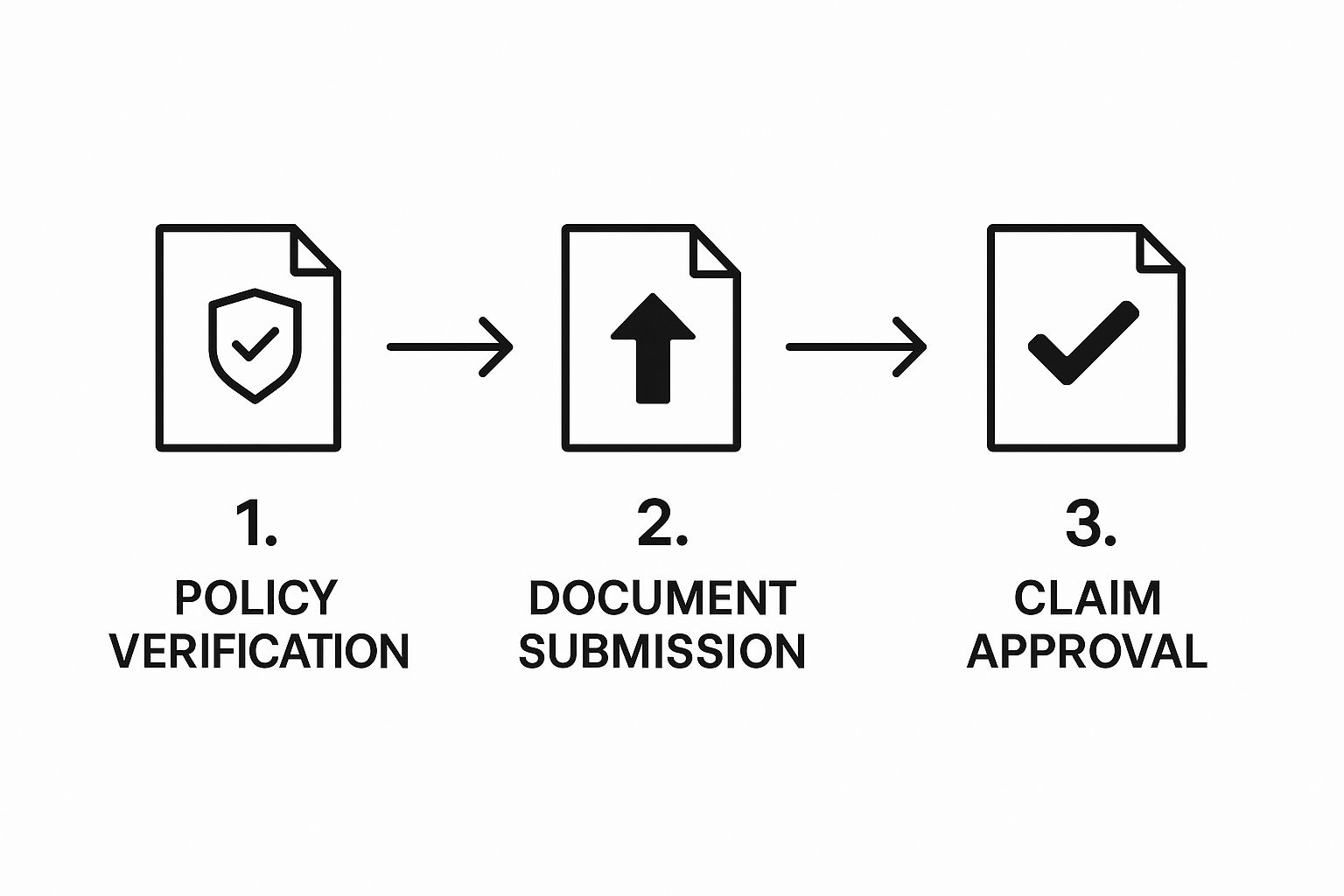Filing a life insurance claim is often the last thing anyone wants to deal with while grieving. It can feel like a mountain of paperwork at the worst possible time. At its heart, the process is straightforward: you notify the insurer, provide a certified death certificate and their claim forms, and then they review everything before issuing the payout. But as with most things involving large sums of money, the details matter.
The Modern Life Insurance Landscape
Before diving into the "how-to," it's helpful to understand the world you're stepping into. The life insurance industry isn't some dusty, unchanging institution. It's a massive, tech-driven field that's constantly evolving, and those changes directly affect how your claim gets handled.
The sheer scale is staggering. In 2025, the market for life insurance claims and services hit an estimated $209.28 billion. It's not slowing down, either—projections show it growing at 13.2% annually. This growth is fueled by new technologies that automate parts of the process. While that can mean faster claims, it also introduces more complexity behind the scenes. You can dig into more of the numbers in these life insurance claims statistics on coinlaw.io.
This isn't just an abstract financial market; it represents real people. Today, about 51% of U.S. adults have some form of life insurance. It's worth noting there's a bit of a gender gap, with 57% of men covered compared to 46% of women.
Why This Bigger Picture Matters For You
Knowing this isn't just for trivia night. It's practical. When you submit a claim, you're interacting with a system built to manage billions of dollars and prevent fraud. That's why the verification process can feel so rigorous. They aren't just looking at your claim; they're managing risk across a portfolio that's bigger than the GDP of some countries. Understanding this helps set realistic expectations for how long things might take and why certain documents are non-negotiable.
The policies themselves have also gotten more diverse. Traditional whole life insurance still makes up 37% of new premiums, but other types are catching up fast. For example, variable universal life premiums jumped by 41% in early 2025. Each product has its own unique rules, so knowing the specifics of your loved one's policy is key.
Connecting Your Claim to What Really Matters
A life insurance payout is never just about the money. It’s what that money does. It’s the tool that helps families navigate one of life's most difficult transitions, providing stability when everything else feels uncertain.
People use these funds for some of the most important expenses they'll ever face:
- Giving their loved one a proper funeral or memorial service.
- Paying off the mortgage to keep the family home.
- Ensuring a child’s education is still secure.
- Creating a unique and personal final tribute, like a service from Aerial Ash Scattering.
Thinking about the process this way transforms it from a bureaucratic headache into a meaningful final task. It’s a crucial part of honoring a legacy and often a key component of comprehensive end-of-life planning.
The life insurance claim is the bridge between the promise made years ago and a family's peace of mind today. Every form you fill out and every call you make is a step toward making that promise a reality.
By understanding the landscape—from the industry's massive scale to the deeply personal impact of the payout—you can navigate this process with more clarity and confidence. This guide is here to walk you through it, one step at a time.
Assembling The Necessary Paperwork
Getting a life insurance claim approved often feels like planning a long trip. If you pack the essentials beforehand, you avoid last-minute scrambles and stress. Gathering every document in one go makes the process smoother, cuts down on calls back and forth, and shows the insurer you’re on top of things.
Treat this step as building a sturdy base for the entire claim. With your paperwork organized, you steer the claim’s pace—and that can mean receiving the benefit faster.
The Core Documents You Cannot Skip
Every insurer will have its own forms, but these items are non-negotiable across the board:
-
Certified Death Certificate
The official proof of passing. Photocopies won’t pass muster—you need a certified copy with a raised seal or stamp from the vital records office. -
Original Policy Document
This holds your policy number, coverage details, and terms. If it’s misplaced, no sweat—the insurer keeps a copy. You’ll just supply identifiers like the deceased’s Social Security number. -
Claimant’s Statement (Claim Form)
Think of this as your formal application for the death benefit. It asks for specifics on the deceased, cause of death, and your beneficiary details. Accuracy is critical here.

Essential Documents for a Life Insurance Claim
Below is a quick overview of the paperwork you’ll need, why it matters, and where to get it:
| Document | Purpose | Where to Obtain |
|---|---|---|
| Certified Death Certificate | Legally confirms the death | County or state vital records office |
| Original Policy Document | Details coverage, policy number, and terms | Your personal files or insurer’s records department |
| Claimant’s Statement Form | Official application for the death benefit | Directly from the insurance company |
| Trust Documents | Verifies trustee’s authority (if trust beneficiary) | Trust’s legal custodian or attorney |
| Letters of Testamentary | Appoints executor (if estate is beneficiary) | Probate court |
Collecting these items in advance keeps your claim moving without unnecessary pauses.
Proactive Tips For Document Gathering
Ordering 5–10 certified death certificates right away is a lifesaver. You’ll need copies for banks, property transfers, and more. Extra copies mean you won’t stall other parts of settling the estate.
Stay vigilant when completing the claim form. A single typo—say, in a Social Security number—can trigger an automated fraud alert and hold everything up. Always double-check dates and names before signing.
Handling Special Circumstances
Some claims demand extra legal proof. For instance, if a trust holds the policy, include a copy of the trust agreement so the insurer can verify the trustee’s role. When the estate is the beneficiary, supply Letters of Testamentary to show who the executor is.
These additional steps ensure the insurer pays the right party. If you’re juggling memorial plans—perhaps an Aerial Ash Scattering service—you may find it useful to review what to include when sending ashes for aerial scattering and keep all your arrangements in order.
Submitting Your Claim with Confidence
You’ve gathered the paperwork, and now it’s time to officially start the claims process. This isn’t just about sending off a stack of documents. It's about communicating clearly and keeping meticulous records to ensure everything goes as smoothly as possible right from the start.

Your first move is to call the insurance company. You can almost always find a dedicated claims number on their website or buried in the policy documents. This first call really sets the stage, so have the policy number, the deceased's full name, and their Social Security number handy before you dial.
Choosing Your Submission Method
Insurance companies usually give you a few ways to get your claim packet to them. Each option has its own trade-offs, so pick the one you're most comfortable with and that gives you peace of mind.
- Online Portal: This is almost always the fastest route. You can upload scanned documents directly and usually get an instant confirmation number. The only real catch is you need to be comfortable with scanning and uploading digital files.
- Certified Mail: This is the old-school, tried-and-true method for a reason. Sending your documents via certified mail gives you a tracking number and a delivery receipt—indisputable proof of when the insurer got everything.
- Through an Agent: If the policy was set up through a local agent, they can be an incredible resource. A good agent will help you fill out the forms correctly and submit everything for you, basically acting as your advocate and guide through the whole process.
No matter how you send it, the goal is the same: get your complete, accurate packet into the right hands without a hitch.
Filling Out the Claim Form Flawlessly
The claimant's statement, or claim form, is the absolute heart of your submission. This is where tiny mistakes can create massive headaches. I always tell my clients to treat it less like a form and more like a sworn statement. Every single detail has to be perfect.
A simple typo in a date of birth or a transposed digit in a Social Security number can easily trip up the process. Even an incomplete address can trigger an automated fraud alert or force the claims department to mail you a request for clarification, tacking weeks onto the timeline.
Take a deep breath and double-check every single field before you sign. Spending an extra ten minutes reviewing the form now is far better than spending ten days waiting on a correction to be processed later.
If you hit a question that seems confusing or ambiguous, don't guess. Just call the claims department and ask. It's literally their job to help you get it right.
The Importance of Meticulous Record-Keeping
From this moment on, you need to document every single conversation and piece of correspondence with the insurance company. This becomes your personal audit trail, and it’s your best defense if anything goes sideways.
I recommend starting a dedicated notebook or a simple digital file to track everything. For every phone call, log this info:
- Date and Time of the Call: Be specific.
- Name of the Representative: Always ask for their full name and write it down.
- Reference or Ticket Number: This is gold for follow-up calls.
- Summary of the Conversation: Briefly note what you discussed, what they promised, and any next steps.
This simple habit protects you. If one representative tells you one thing and another tells you something different, your notes are the proof you need to hold them to their word.
It’s important to remember the scale of this industry. Globally, life insurance payouts hit a staggering $831 billion in 2023, with the U.S. market making up nearly 27% of all premiums. You can dig into more of these life insurance statistics on feather-insurance.com. These numbers show that insurers have massive, complex systems for handling claims. But it also means that without diligent follow-up, an individual claim can easily fall through the cracks.
By submitting your claim with precision and keeping flawless records, you shift from being a passive beneficiary to an active manager of the process. You're taking control to ensure the financial support intended for your family—whether for daily bills or a memorial like one from Aerial Ash Scattering—is secured without any needless delays.
Understanding the Insurer's Review Period
After you’ve carefully gathered and sent in all the claim documents, the waiting game begins. This is often the most stressful part of the entire process because the ball is now in the insurer's court. But knowing what’s happening behind the scenes can ease some of that anxiety and help you set realistic expectations.
Rest assured, the insurance company isn’t just letting your paperwork collect dust. They've kicked off a detailed review to verify every piece of information. It's a standard procedure, designed to guard against fraud and ensure they meet all their contractual obligations before paying out what is often a substantial amount of money.

This verification process is a cornerstone of a massive global industry. In 2024, total global insurance premium income hit EUR 7.0 trillion, with life insurance making up EUR 2,902 billion of that. The industry grew by 8.6% in 2024, and North America led the pack with an 8.2% increase in premiums. These numbers really highlight why insurers need ironclad systems to handle a huge volume of claims accurately. You can discover more insights about these global insurance trends on allianz.com.
What Happens During the Review
Once the insurance company receives your claim, it lands on the desk of a claims examiner. Their job is to perform due diligence on several key details. This isn't personal—it's just a necessary, procedural step for every single claim they process.
Here’s a quick look at what they’re typically checking:
- Policy Status: Was the policy active when the insured passed away? They’ll pull up payment records to make sure there were no missed premiums or lapses in coverage.
- Beneficiary Information: They need to confirm that you are, in fact, the designated beneficiary. Your identity will be matched against the information on file.
- Cause of Death: Does the cause of death on the certificate fall within the policy's terms? They’re looking for any specific exclusions, like a death that occurred during a high-risk hobby that wasn't disclosed.
- Contestability Period: This is a big one. If the death occurred within the first two years of the policy, expect a much more thorough investigation.
Think of the review period as a necessary pause, not a red flag. Insurers are legally required to pay valid claims, but they also have a duty to prevent fraudulent payouts.
The Contestability Period Explained
One of the biggest things that can stretch out the review timeline is the contestability period. This is almost always the first two years after a life insurance policy starts. If the insured person dies during this window, the insurance company has the right to dig into the original application to check for any "material misrepresentations."
What does that mean in the real world? Let’s say the insured didn't mention a serious heart condition on their application and then died of a heart attack 18 months later. The insurer could potentially deny the claim. They aren't looking for tiny mistakes; they're looking for major omissions that would have changed their decision to issue the policy in the first place.
An investigation like this can easily add weeks, or even months, to the claim process. The insurer will likely request old medical records, statements from doctors, and other documents to piece together the insured's health status when they first applied.
Following Up on Your Claim Status
Waiting for a decision is never easy, especially when you're also coping with grief. This period can be incredibly tough and often involves dealing with work as well. If you need help navigating that, you might find our guide on bereavement leave policies useful.
It is absolutely okay to check in on your claim's status. A good rule of thumb is to give them about two weeks after you’ve confirmed they received your documents before making the first call.
When you do call, make sure you have your claim number handy. Be polite but direct. You can simply say you're calling for a status update and ask if there’s any other information they need from you. This proactive, yet patient, approach keeps the lines of communication open and helps move your claim one step closer to resolution.
How to Handle a Claim Denial or Payout Issue
It's a gut punch. Getting a denial letter for a life insurance claim, on top of everything else you're going through, can feel overwhelming. But here's something I've learned from years in this field: a denial is rarely the final word. It's usually the start of a conversation.
Think of it less as a "no" and more as a "we need more information." Most of the time, you can successfully appeal a denial if you're methodical and have your facts straight. The key is to understand exactly why the claim was rejected so you can build a strong case.
Decoding the Reasons for Denial
Insurance companies are required by law to tell you why they denied the claim, and they have to put it in writing. This letter is your roadmap. While every situation is different, most denials boil down to a few common reasons.
- Policy Lapse: This is probably the most common. It means payments were missed, and the policy wasn't active when the person passed away. Sometimes, though, there are mistakes regarding grace periods that can be successfully challenged.
- Material Misrepresentation: This one's a bit more serious. It means the insurer found something on the original application that they believe was false or left out on purpose—like not mentioning a pre-existing condition or a risky hobby like scuba diving.
- Exclusion Clause: Buried in the policy's fine print are specific situations that aren't covered. For example, many policies won't pay out if the death occurred during the commission of a felony.
A newer trend we're seeing is insurers using AI to screen claims. These systems might scan everything from social media posts to pharmacy records and flag a claim. Unfortunately, an algorithm can't understand human context, which can lead to a perfectly valid claim being unfairly denied.
Structuring Your Appeal
Once you have that denial letter, it's time to build your response. Your appeal is your formal chance to present your side of the story and provide evidence that refutes their decision. This isn't about writing an emotional plea; it's about a clear, fact-based argument.
Your appeal needs to be a formal letter that directly tackles their reason for denial. If they claim the policy lapsed, you can provide bank statements proving the premiums were paid on time. If it's a misrepresentation issue, you might need to gather old medical records or signed affidavits to set the record straight.
An appeal is your chance to correct the record. Treat it as a business negotiation where your evidence speaks louder than your frustration. A well-documented, professional appeal has a much higher chance of success.
Pay close attention to deadlines. Most insurers give you a specific window to file an appeal, often around 180 days, so you need to move quickly.
Addressing Payout Problems Beyond Denial
Sometimes the problem isn't a flat-out denial but another headache. Maybe the payout is taking much longer than the standard 30-60 days, or the check is for less than you expected because of an old policy loan you didn't know about.
In these cases, your best tools are persistence and documentation. Keep a detailed log of every phone call—date, time, who you spoke with, and what was said. Follow up every call with an email to create a paper trail. If you feel like you're being stonewalled, it's time to escalate.
When to Seek Professional Help
If your appeal gets denied or the whole process just feels like too much to handle on your own, don't be afraid to call in a professional. A life insurance attorney who specializes in this area can be a game-changer. They know the ins and outs of insurance law and can fight for you, often on a contingency basis, meaning they only get paid if you do.
For any complex claim issues or if you need guidance on services like those provided by Aerial Ash Scattering, clear communication is essential. You can always reach out for a consultation, and if you need to speak with our team directly, you can get in touch with our specialists for support. Remember, you have rights, and there are people who can help you stand up for them.
Common Questions About the Claim Process
Even the most straightforward guide can't cover every specific scenario that might pop up. When you're in the middle of this process, it's natural for questions to surface. I've been through this with countless families, and a few key questions come up time and time again. Let's tackle them head-on.

Getting clear answers is about more than just checking boxes; it’s about giving you the confidence to handle this difficult task without added stress.
How Long Do I Have to File a Claim?
Technically, there isn't a hard-and-fast deadline for filing a life insurance claim. You could discover a policy years down the road and still be able to file.
However, I always advise people to start the process as soon as they feel ready. Filing promptly just makes everything smoother. Key documents, like the certified death certificate, are much easier to get your hands on shortly after a passing. More importantly, most states require insurers to pay interest on the death benefit from the date of death, so a quick filing ensures you get the funds when you need them most and receive the full amount you're entitled to.
What if We Cannot Find the Original Policy?
Don't panic. Misplacing the original policy document is incredibly common and it absolutely will not stop you from making a claim. The insurance company has the official record, and that's what truly matters.
If the paperwork is missing, your first move is to contact the insurer. You'll need to provide the deceased's full name, date of birth, and Social Security number so they can pull up the records. They might have you sign a "lost policy" affidavit, but they’ll walk you through their exact requirements. Of course, it’s always worth checking the obvious places first—a safe deposit box, personal files, or with their attorney.
Are Life Insurance Payouts Taxable Income?
This is a big one, and the news is good for most people. In almost all cases, a lump-sum death benefit from a life insurance policy is received 100% income-tax-free. It's one of the primary reasons life insurance is such a powerful financial planning tool.
That said, there are a couple of situations to watch out for:
- Installment Payouts: If you opt to receive the payout over time instead of all at once, any interest that the principal earns while the insurer holds it is generally considered taxable income.
- Estate Taxes: If the benefit is paid to the deceased's estate rather than a named individual, and the total estate is large enough to trigger federal or state estate taxes, the payout could become part of that taxable amount.
It's always smart to have a quick chat with a financial advisor to see how this applies to you. They can help you plan for everything from immediate needs to understanding final expenses, like the differences between cremation vs. burial costs.
At Aerial Ash Scattering, we know that navigating these final arrangements can feel overwhelming. Our mission is to provide a seamless, beautiful, and respectful service to honor your loved one. To see our unique memorial options, please visit us at https://ashdive.com.


